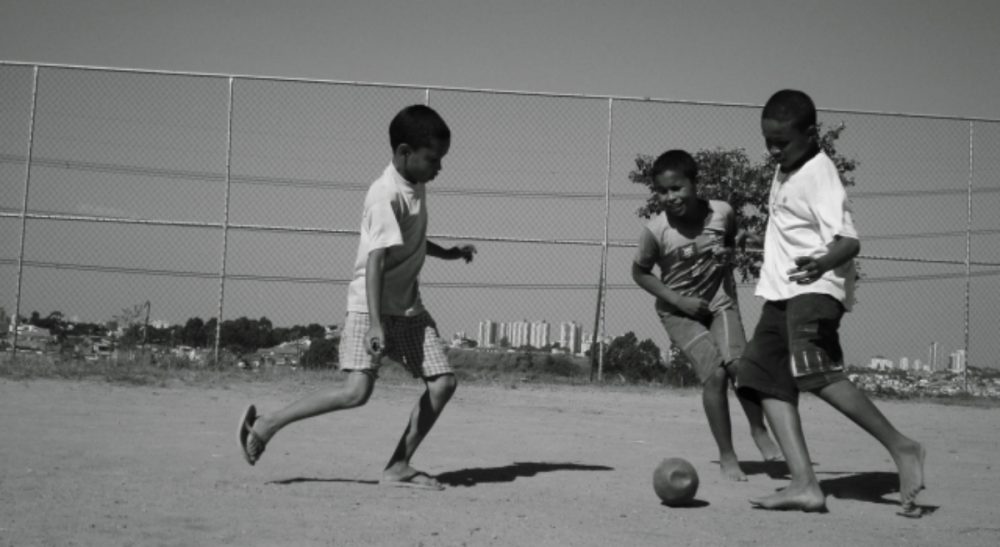Advertisement
For The Love Of The Game, A Yellow Card For FIFA

The 2014 World Cup is over. The champions from Germany have picked up their ball and gone home. Over the last several weeks, millions of Americans fell in love with o jogo bonito, the beautiful game, delighting in the opportunity to party with the rest of the world and to have the cry of “U-S-A!” be about making goals, not war. The soccer on display in Brazil was, to be sure, the sport at its most skilled and accomplished. But to my mind, it was not the game at its purest, or even its most beautiful.
Years ago, as a Peace Corps volunteer in northeast Brazil, for pick-up games in my remote village, we’d strip down to our skivvies and bare feet and hit the dusty pitch — yes, even this hilariously hopeless americano who’d never advanced beyond recess kickball. In 1970, as the World Cup in Mexico loomed, I watched, amazed, as Brazil overcame years of political and engineering ineptitude to complete rural electrification projects so that fans in the hinterlands could watch the games via televisão, an invention that was said to draw pictures from the air. Technology lifted us out of the darkness; we stood transfixed before a flickering TV mounted in the public square. When Pelé and our other heroes won the Cup, the entire country celebrated like carnaval, only more so. (Alas, none of that this year after Brazil’s horrible loss to Germany.)
The beautiful game: Yes, it’s that and always will be, at the sandlot level. But big-time soccer has acquired some ugly aspects.
The beautiful game: Yes, it’s that and always will be, at the sandlot level. But big-time soccer has acquired some ugly aspects. Among the fans, there is racism and hooliganism in too many parts of the world. At the higher and mightier levels, the beautiful game is rife with corruption, bribery and match fixing. Presiding over this mess, and contributing to much of it, is FIFA (Fédération Internationale de Football), long noted for its arrogance and resistance to change.
We will leave it to Interpol to deal with soccer’s off-field criminality. As for on-field injustice, some simple steps can be taken. As if stuck in the 19th-century version of the game it took over in 1904, FIFA still leaves in-game enforcement to a single referee. This is an impossible task, given soccer’s 22 players and their unprecedented speed, guile and skill that spreads across the game’s vast playing surface. Multiple blown calls or non-calls (as confirmed by video replay) by referees and their sideline “assistants” (linesmen) undoubtedly affected the outcome of games in this year’s Cup. Compared with the showcase tournaments of other top professional sports, this degree of error is unacceptable.
Because the referee alone wields such enormous power over the results of these big-money games, the players must and can work him over psychologically. Hence the grotesque comedy of dives, near-death agonies, gesticulations, supplications and ingratiations the players direct at the ref. The hope is that the cumulative effect of such theatrics will wear him down and yield the foul upon which so many of these contests turn. The players know that these “embellishments” (illegal, according to FIFA law, though virtually never called) are a travesty and wrong, as the Netherlands star Arjen Robben admitted in Brazil. Nonetheless, players do it, willingly disrespecting the integrity of the game to which they owe everything. “Cynical,” as the Brit announcers might say. Where is the beauty in that?
Purists will protest that technology will spoil the game, but that isn’t so. Far from hurting the sports that use it, technology makes the games fairer, more just, less contentious and more appealing...
FIFA needs to follow other major sports by flooding the field with officials. Consider that Major League Baseball (steeped in history and tradition as much as soccer, and snail-paced by comparison) uses six on-field umpires for its post-season.
Even more important, FIFA must embrace technology. Purists will protest that technology will spoil the game, but that isn’t so. Far from hurting the sports that use it, technology makes the games fairer, more just, less contentious and more appealing precisely because it reveals mistakes, reduces players’ and coaches’ histrionics and puts the focus back on the games themselves. Technology has the capacity to strip away soccer’s disruptive excesses.
For this year’s World Cup, FIFA relented after years of pressure and introduced video review to verify goals. As baseball, the NFL, international tennis and other sports have done, FIFA should also adopt in-game challenges. Backed by technology, the in-game challenge can unmask the phantom foul, reveal the blown off-side call that negates a goal, turn a corner kick into a goal kick, hand a yellow card to an embellisher and take pressure off the officials to make the perfect call every time.
The lights have gone out in Brazil’s shiny, near-billion-dollar stadiums. Their sad, slow decline into disuse now begins. Beyond them, the grassroots game goes on, unfazed, played — as always — in any conceivable space, using whatever works as a ball, in every corner of the world, simply for the joy of it. Big-time soccer needs to take note of that and understand that it must evolve in order to get back to its beautiful roots.
_
Related:
